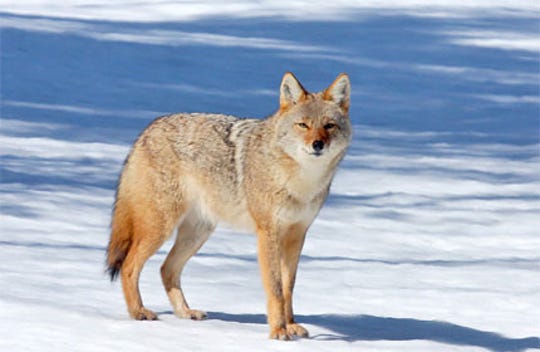Cathy Kozlowicz, Milwaukee Journal Sentinel
Could there actually be a wolf in Menomonee Falls?
A post on the Menomonee Falls (Area) Crime and Community Information Facebook page claims that’s the case.
The post says a wolf was spotted Nov. 1 in an open field by Pop’s Custard, N87 W16459 Appleton Ave., heading toward Walmart. The woman who made the post did not respond to efforts to speak to her about her experience.
Social media users are divided over what the woman described as a wolf was actually a wolf or a coyote. The latter is much more likely, as coyotes are much more common in this part of the state, said Dianne Robinson, wildlife biologist for the Wisconsin Department of Natural Resources.
Still, the possibility remains that it could have been a wolf.
“It is not impossible,” said Robinson. “Without any kind of solid evidence, it is impossible to know for sure.”
Robinson said wolves breed mostly in the northern part of the state, but since the 1970s, there has been a confirmed wolf sighting in every Wisconsin county. Locally, there was a wolf sighting in Oconomowoc about 10 years ago, she said. More recently, a wolf was scene in West Bend four to five years ago.
The DNR puts the 2018-19 minimum wolf count at 914-978, just slightly higher than the 2017-18 minimum count of 905-944.
“They (wolves) are not common,” said Robinson, adding that coyotes are much more likely to be seen in this area. Large domestic dogs could be mistaken for wolves, she said.
Wolf or coyote?
One of the biggest differences between a coyote and a wolf is its size. “A wolf is about twice the size of a coyote,” said Robinson.
Wolves range from 50 to 100 pounds, while coyotes range from 25 to 45 pounds, according to the DNR.
“A coyote has a long, narrow snout and tall, narrow ears,” Robinson said. “A wolf is chunkier and robust.”
According to the Wisconsin DNR website, a wolf has a relatively large head with broad cheeks; facial markings are well-blended and lack distinguishable borders; ears have a lot of fur and are erect and rounded; light-colored slanted eyes range from amber to yellow; and long legs with large, wide front feet and smaller back feet.
The animals can have similar colors. Both wolves and coyotes are a mix of tan, brown, black and gray; some are black. Coyotes, however, tend to be lighter in color and have pointier ears than wolves, according to the DNR.

The state Department of Natural Resources has said that although it is possible there was a wolf spotted in Menomonee Falls, it is more likely that it was a coyote, like the one pictured here. Coyotes are lighter in color, have pointed noses and are about half the size of wolves. (Photo: Department of Natural Resources)
History of wolves in Wisconsin
Wolves are native to Wisconsin, with an estimated 3,000 to 5,000 of the animals in the region in the 1830s, before it became a state (in 1848). Early farmers freely trapped and hunted the wolves. After Wisconsin attained statehood, the Legislature offered a $5 bounty. By 1900, there were no wolves in the southern two-thirds of the state, and in 1960, wolves were declared to be extirpated from the state, according to the DNR.
But in the 1970s, wolves made a comeback in Wisconsin, migrating from a wolf pack in neighboring Minnesota, Robinson said.
The gray wolf is on the federal endangered species list, according to the DNR website. However, the U.S. Fish & Wildlife Service has submitted a proposal seeking to remove them from that list.
If you see a wolf
Robinson said that if you see a wild animal, you should give it space and distance. “It is important to give it (a possible wolf) a healthy amount of space,” she said.
“And give a close eye to your pets,” she suggested.
“I think many people get excited when something unusual pops up. It is kind of exciting,” she said.
Confirming whether it is a wolf
Robinson said if you see an animal you think might be a wolf, you should take pictures of the footprints and of the animal, itself, if possible, to help confirm the animal’s species.
“We had a decent amount of snow to take the pictures,” she said. Then, be sure to submit the photos to the DNR at http://bit.ly/WILargeAnimalObservation.
